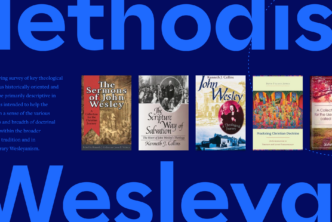 First Peter is a beloved part of the New Testament. However, we live far from the original setting, and things such as “living stones” and women who shouldn’t braid their hair are unfamiliar to us. How can we understand something written so long ago? Many have sought to answer these questions—Karen H. Jobes in the BECNT commentary series and Paul J. Achtemeier in the Hermeneia series are two great examples. Both authors discuss 1 Peter, allowing their readers to understand the text and be inspired by God’s Word all over again.
First Peter is a beloved part of the New Testament. However, we live far from the original setting, and things such as “living stones” and women who shouldn’t braid their hair are unfamiliar to us. How can we understand something written so long ago? Many have sought to answer these questions—Karen H. Jobes in the BECNT commentary series and Paul J. Achtemeier in the Hermeneia series are two great examples. Both authors discuss 1 Peter, allowing their readers to understand the text and be inspired by God’s Word all over again.
Introduction
The size of the Hermeneia volume signifies this commentaries’ wealth of knowledge. An understanding of biblical Greek will be helpful when reading it, though not entirely necessary. While the BECNT is academically profound, the text also includes transliterations for readers who are not skilled in biblical Greek. This first blog post in a series will look at key points in each of these commentary’s introductions, and later posts will look at their responses to the actual content of 1 Peter.
Authorship and date
Jobes and Achtemeier agree that the author of 1 Peter used the ancient Greek translation of the Old Testament, the Septuagint (LXX), when writing his letter, rather than the Masoretic Text (MT). This indicates that the author was familiar with the Greek Bible. Achtemeier claims that the author of 1 Peter is likely someone other than Simon Peter and that the letter lacks influence from the Hebrew Bible which would have been expected from the apostle who was sent to preach to the Jews (Gal. 2:7). However, as Achtemeier explains, some scholars argue that Peter would have had some knowledge of Greek as a fisherman, and he would have improved his Greek skills in order to fulfill his mission. Overall, Achtemeier leans toward a pseudonymous authorship at a later date (AD 80–100). Karen Jobes defends her position of an earlier date and authorship by the apostle Peter, explaining that the late date was from the recently rejected source-critical assumptions. Her study brings new evidence that the letter was written during the lifetime of Peter, giving it a likely earlier date. The debate about authorship and date continue in each text while the authors each come to their own stance, though they both lack any definite conclusions based on the evidence.
Recipients
Jobes explains that ancient scholars believed the recipients of 1 Peter were likely converts from Judaism. However, some modern scholars disagree and point to 1:18 and 4:3, arguing that first-century Jews would never be described as having a “useless way of life.” They instead believe the recipients would have been Gentile converts. But Jobes questions this argument, using 1:18–19 as evidence for the author’s reference to redemption and the old covenant sacrificial system (the blameless and spotless lamb). Despite having sufficient evidence of a Jewish audience, Achtemeier and Jobes both point out possibilities that suggest a Gentile audience, and both similarly conclude that they lack any definitive answers. Achtemeier explains that the safest option might be to assume a mixed audience of Jews and Gentiles, while Jobes points out that Jewish Christians may very well have been living like pagans. It doesn’t really matter if the readers were Jew or Gentile for they are both guilty before God and in need of this new covenant relationship.
Jobes explains the importance of Roman colonization in Asia Minor, which provided a military presence in the empire. The Roman emperor sent loyal citizens—including slaves who had been freed and granted citizenship—to immigrate to and live in designated Roman colonies. She describes who was included in the Roman colonization, as well as its impact on everyone involved. In light of 1 Peter, she emphasizes that this may explain the use of the term “foreigner” or “exile.” Achtemeier also accounts for the Roman Empire, explaining that these “exiles” were called such due to their living somewhere other than their native land. In his response to the Roman Empire at this time, Achtemeier focuses his attention on the likelihood of official persecution by the Roman emperors, with the hopes of tracing such persecution to a specific time in order to make a claim for authorship.
Purpose
The letter, according to Jobes, states its purpose in 5:12 as standing firm in the true grace of God. She adds that Peter also wished to strengthen and correct his readers, and he wanted them to stand boldly in their faith despite situations that caused them confusion and suffering. Achtemeier explains that the author of 1 Peter hoped to comfort these particular Christian communities, pointing out that the letter provides hope by looking toward the future redemption and defeat of suffering. Achtemeier and Jobes agree that the figure of Jesus Christ is essentially core to the author’s message.
* * *
We’ve only scratched the surface of these two commentaries on 1 Peter. To read more, pick up a copy of Karen H. Jobes’ volume on 1 Peter from the Baker Exegetical Commentary on the New Testament and get the Hermeneia: New Testament series with Paul J. Achtemeier’s volume.




